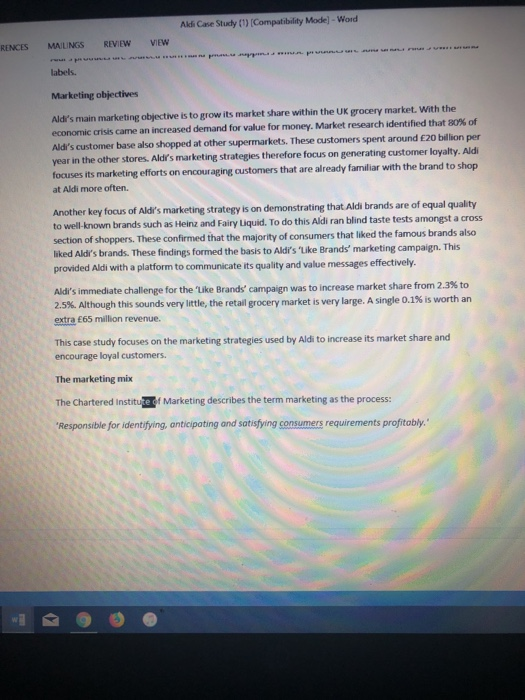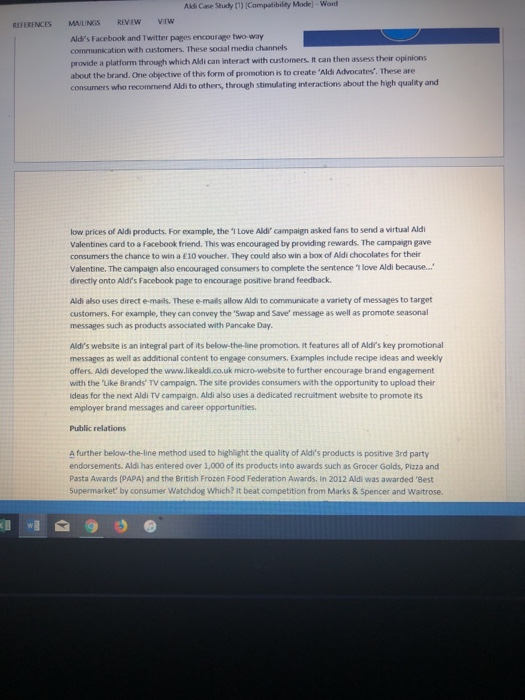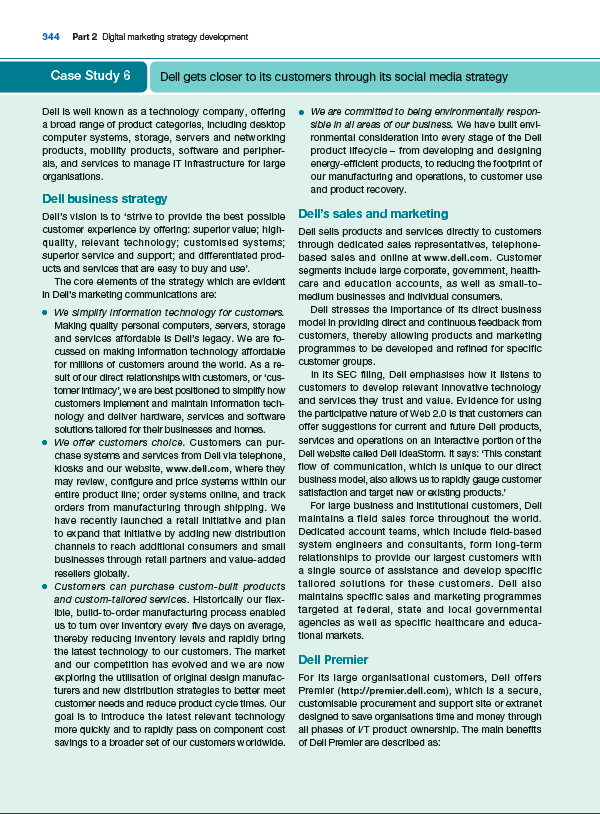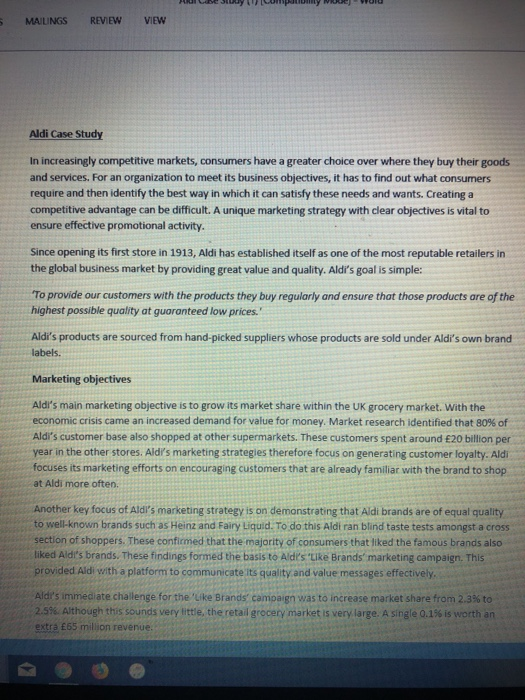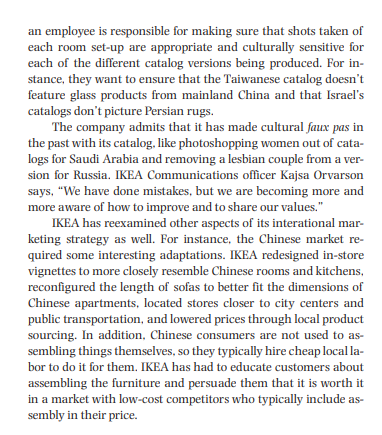,marketing
1.
Ald Case Study (1) [Compatibility Mode] - Wod RENCES MAILINGS REVIEW VIEW labels. Marketing objectives Aldi's main marketing objective is to grow its market share within the UK grocery market. With the economic crisis came an increased demand for value for money. Market research identified that 80% of Aldi's customer base also shopped at other supermarkets. These customers spent around $20 billion per year in the other stores. Aldi's marketing strategies therefore focus on generating customer loyalty. Aldi focuses its marketing efforts on encouraging customers that are already familiar with the brand to shop at Aldi more often. Another key focus of Aldi's marketing strategy is on demonstrating that Aldi brands are of equal quality to well-known brands such as Heinz and Fairy Liquid. To do this Aldi ran blind taste tests amongst a cross section of shoppers. These confirmed that the majority of consumers that liked the famous brands also liked Aldi's brands. These findings formed the basis to Aldi's 'Like Brands' marketing campaign. This provided Aldi with a platform to communicate its quality and value messages effectively. Aldi's immediate challenge for the 'Like Brands' campaign was to increase market share from 2.3%% to 2.5%. Although this sounds very little, the retail grocery market is very large. A single 0.1% is worth an extra E65 million revenue. This case study focuses on the marketing strategies used by Aldi to increase its market share and encourage loyal customers. The marketing mix The Chartered Institute of Marketing describes the term marketing as the process: 'Responsible for identifying, anticipating and satisfying consumers requirements profitably." 9ma loaner on proving beauty products bat inechocurator atvel to limes brands. Add's comeing on quality Promotions -Ald uses a combination of above the ine and bow they ind promotions with a loom on its 'Vine Brands' and "Swap & Saw canpages. be AlDA model can be used to demonstrate theAldi Case Study (1) [Compatibility Mode] - Word ENCES MALINGS REVIEW VIEW he AIDA model can be used to demonstrate the aim of any promotional activity: Initiate awareness amongst customers. Generate interest for and desire to have i Interval the product(s)- Leading to customers taking action to purchase. Aldi uses a variety of communication methods notion and channels to increase the impact of it's promotional activity and meet the aims of AIDA. Balancing the mix Organizations need a balanced marketing mix to meet the needs of its customers. Aldi's focus is on offering the best possible quality products at the lowest possible prices. Every buyer for Aldi, from fresh fruit and vegetables to meats and electronics, is an expert in their field. They look for products from around the world. This enables them to get the finest quality products that Aldi then sells under its own brand labels. Price Selecting the prices is one of the most difficult considerations when developing a marketing mix. Different pricing strategies that are commonly used include: . Market penetration - charging lower prices for new products to help them enter the market and gain market share quickly.MAILING REVIEW ViW Market penetration - charging lower prices for new products to help them enter the market and gain market share quickly. Competitive pricing - pricing at a slightly lower prices than competitors, Strategic pricing - emphasizing the quality or brand positioning of a product to allow a higher price to be charged. Competitive pricing is a key strategy for Aldi, Aldi is able to offer quality products at low prices as it buys in great volume. The fact that Aldi buys such large quantities of these products allows great leverage for negotiating the best possible prices with its suppliers. This is called economies of scale, Buying large quantities of each product allows Aldi to pass these savings to its customers, Place The place element of the marketing mix involves identifying where the product or service will be sold. Aldi keeps its store layouts simple to limit waste and keep costs down. This means Aldi can focus on offering its customers the lowest possible prices for its products. When considering new store locations, Aldi takes into account: the number of people visiting an area as well as the demographic of the area - for example, the population of the area should be more than 30,000 people the position of store - Aldi focuses on edge of the town centre locations with good visibility from a main road and not too much competition the accessibility of the store and its public transport links the number of parking spaces available. Above-the-line promotion For Aldi to achieve its objective of increasing its market share, it had to ensure its promotional activity demonstrated the balance of its marketing mix. For example, to increase customer loyalty it had to communicate its key quality and value messages. Promotion helps to: increase awareness and improve brand recognition increase demand for products improve brand image highlight the superiority of products and services.Abdi Case Starty (1) [Compatibility Mode] - Wood FERENCES MAILINGS Above the-line promotions are paid for advertising aimed at a mass audience. These include the media such an television, radio, magazines and newspapers that reach a large number of people. This form of promotion can be costly. It can also be difficult to target specific audiences. Aldi uses a range of above- the line methods to reach its customers and potential customers. These include: Advertising on television. The 'Like Brands' campaign features 20 second television adverts which focus on a particular product. The adverts show a famous brand as a benchmark for quality side by side with an Aldi brand product. They use the slogan 'Like Brands. Only Cheaper'. This reinforces the message that Aldi products are cheaper than leading brands but equal in terms of quality. The adverts provide personality to the Aldi brand. They use humour which helps to build trust and an emotional connection with target audiences. Printed leaflets are distributed within stores (1 million copies printed per week) and also to customers living in areas surrounding stores. These leaflets help to reinforce the 'Like Brands" campaign. They also showcase products with limited availability and seasonal offers available in stores. Newspaper adverts extend the "Like Brands' campaign and help to showcase a variety of product categories. They also communicate Aldi's "Swap and Save' message. This campaign demonstrates the amount that shoppers could save if they swapped their weekly shop to Aldi. They compared Aldi products to famous brands to demonstrate Aldi's value for money message. In store posters are also used to highlight the "Swap and Save' message Below the line promotion Below-the-line promotion uses different ways to engage with customers. These methods can be more easily targeted to specific audiences than above-the- line methods. They offer organisations a greater level of control over their communications. Aldi uses a range of below-the-line methods. These include: social media targeted e mails to customers ard party endorsement and awards public relations and media relations. Aldi's Facebook and Twitter pages encourage two-way communication with customers. These social media channelsAldi Case Study (1] [Compatibility Mode] - Word REFERENCES MAILINGS REVIEW VIW Ald's Facebook and Twitter party encourage two way communication with customers. These social media channels provide a platform through which Aldi can interact with customers, It can then assess their opinions about the brand. One objective of this form of promotion is to create "Aldi Advocates'. These are consumers who recommend Aldi to others, through stimulating interactions about the high quality and low prices of Aldi products. For example, the 'I Love Aldi' campaign asked fans to send a virtual Aldi Valentines card to a Facebook friend. This was encouraged by providing rewards. The campaign gave consumers the chance to win a E10 voucher. They could also win a box of Aldi chocolates for their Valentine. The campaign also encouraged consumers to complete the sentence "I love Aldi because...' directly onto Aldi's Facebook page to encourage positive brand feedback. Aldi also uses direct e-mails. These e-mails allow Aldi to communicate a variety of messages to target customers, For example, they can convey the "Swap and Save' message as well as promote seasonal messages such as products associated with Pancake Day. Aldi's website is an integral part of its below-the line promotion. It features all of Aldi's bey promotional messages as well as additional content to engage consumers, Examples include recipe ideas and weekly offers. Aldi developed the www.likealdLoco.uk micro-website to further encourage brand engagement with the 'Like Brands' TV campaign. The site provides consumers with the opportunity to upload their ideas for the next Aldi TV campaign. Aldi also uses a dedicated recruitment website to promote its employer brand messages and career opportunities. Public relations A further below-the-line method used to highlight the quality of Aldi's products is positive 3rd party endorsements. Aldi has entered over 1,000 of its products into awards such as Grocer Golds, Pizza and Pasta Awards [PAPA) and the British Frozen Food Federation Awards. In 2012 Aldi was awarded 'Best Supermarket' by consumer Watchdog Which? It beat competition from Marks & Spencer and Waitrose.Ald Case Study Ill [Compatibility Made] - Word REFERENCES MAILINGS REVIEW VIEW A further below the line method used to highlight the quality of Aldi's products is positive And party endorsements. Adi has entered over 1,090 of its products into awards such as Grocer Golds, Pizza and Pasta Awards [PAPA] and the British Frozen Food Federation Awards. In 2012 Akhi was awarded "Test Supermarket' by consumer Watchdog Which? It beat competition from Marks & Spencer and Waitrose. Further positive endorsements for products on TV and in the press reaffirm the message that Aldi products are of the highest quality as well as being great value for money. For example, Aldi's Christmas pudding was awarded runner-up and acknowledged as a 'bargain' in a taste test comparison in Good Housekeeping magazine. Effective public and media relations help to create positive press exposure. Aldi has secured record coverage through hard working and innovative media relations. Journalists from newspapers such as The Grocer, The Financial Times and The Times were invited for exclusive interviews with Aldi's Group Managing Directors. They discussed record breaking sales results. Further coverage was gained through targeting key media at specific times with seasonal promotional messages. The "Swap & Save' campaign highlighted the savings available through shopping at Aldi at times when value for money is high on the agenda. This was particularly relevant with its "Back to School and Christmas products. Condusion Aldi has a distinct approach to retailing that has given it a competitive advantage in a crowded marketplace. Aldi's unique balance of the marketing mix enables it to provide high quality, own branded products at the lowest possible price. Aldi's innovative 'Like Brands' and "Swap & Save' marketing campaigns are improving brand perceptions. They are aiding the achievement of Aldi's marketing objectives. The campaigns have increased Aldi's sales per store by +100%% over 3 years through creating more loyal customers. It's multi-channel promotional activity is engaging consumers and creating positive feedbackobjectives The campaigns have increased Aldi's sales per store by + 100% over 3 years through creating more loyal customers. Its multi-channel promotional activity is engaging consumers and creating positive feedback. 1. Describe what is meant by the term marketing. 2. Explain why it is important to balance the marketing mix. 3. Analyse the factors that might affect the location of a new Aldi store. 4. Evaluate how Aldi has identified a unique position within a competitive marketplace.344 Part 2 Digital marketing strategy development Case Study 6 Dell gets closer to its customers through its social media strategy Dell is well known as a technology company, offering . We are committed to being environmentally respon a broad range of product categories, Including desktop sible in all areas of our business. We have built ent computer systems, storage, servers and networking ronmental consideration Into every stage of the Dell products, mobility products, software and peripher- product lifecycle - from developing and designing als, and services to manage IT Infrastructure for large energy-efficient products, to reducing the footprint of organisations. our manufacturing and operations, to customer use and product recovery. Dell business strategy Dell's vision Is to 'strive to provide the best possible Dell's sales and marketing customer experience by offering: superior value; high- Dell sells products and services directly to customers quality, relevant technology; customised systems; through dedicated sales representatives, telephone- superior service and support; and differentiated prod- based sales and online at www.dell.com. Customer ucts and services that are easy to buy and use' segments Include large corporate, government, health- The core elements of the strategy which are evident care and education accounts, as well as small-to- In Dell's marketing communications are: medium businesses and Individual consumers. . We simply Information technology for customers. Dell stresses the Importance of its direct business Making quality personal computers, servers, storage model In providing direct and continuous feedback from and services affordable is Dell's legacy. We are to- customers, thereby allowing products and marketing cussed on making Information technology affordable programmes to be developed and refined for specific for millions of customers around the world. As a re- customer groups. sult of our direct relationships with customers, or 'cus- In Its SEC filing, Dell emphasises how it listens to tomer Intimacy', we are best positioned to simplify how customers to develop relevant Innovative technology customers Implement and maintain Information tech- and services they trust and value. Evidence for using hology and deliver hardware, services and software the participative nature of Web 2.0 Is that customers can solutions tallored for their businesses and homes. offer suggestions for current and future Dell products, . We offer customers choice. Customers can pur- services and operations on an Interactive portion of the chase systems and services from Dell via telephone, Dell website called Dell Ideastorm. It says: 'This constant klosks and our website, www.dell.com, where they flow of communication, which is unique to our direct may review, configure and price systems within our business model, also allows us to rapidly gauge customer entire product line; order systems online, and track satisfaction and target new or existing products.' orders from manufacturing through shipping. We For large business and Institutional customers, Dell have recently launched a retall Initiative and plan maintains a field sales force throughout the world. to expand that Initiative by adding new distribution Dedicated account teams, which Include field-based channels to reach additional consumers and small system engineers and consultants, form long-term businesses through retall partners and value-added relationships to provide our largest customers with resellers globally. a single source of assistance and develop specific . Customers can purchase custom-bull products tallored solutions for these customers. Dell also and custom-tailored services. Historically our flex- maintains specific sales and marketing programmes Ible, build-to-order manufacturing process enabled targeted at federal, state and local governmental us to tum over Inventory every five days on average, agencies as well as specific healthcare and educa- thereby reducing Inventory levels and rapidly bring tional markets. the latest technology to our customers. The market and our competition has evolved and we are now Dell Premier exploring the utilisation of original design manufactory its large organisational customers, Dell offers turers and new distribution strategies to better meet Premier (http://premier.dell.com), which is a secure, customer needs and reduce product cycle times. Our customisable procurement and support site or extranet goal is to Introduce the latest relevant technology designed to save organisations time and money through more quickly and to rapidly pass on component cost all phases of IT product ownership. The main benefits savings to a broader set of our customers worldwide. of Dell Premler are described as:MAILINGS REVIEW VIEW Aldi Case Study In increasingly competitive markets, consumers have a greater choice over where they buy their goods and services. For an organization to meet its business objectives, it has to find out what consumers require and then identify the best way in which it can satisfy these needs and wants. Creating a competitive advantage can be difficult. A unique marketing strategy with clear objectives is vital to ensure effective promotional activity. Since opening its first store in 1913, Aldi has established itself as one of the most reputable retailers in the global business market by providing great value and quality. Aldi's goal is simple: To provide our customers with the products they buy regularly and ensure that those products are of the highest possible quality at guaranteed low prices.' Aldi's products are sourced from hand-picked suppliers whose products are sold under Aldi's own brand labels. Marketing objectives Aldi's main marketing objective is to grow its market share within the UK grocery market. With the economic crisis came an increased demand for value for money. Market research identified that 80% of Aldi's customer base also shopped at other supermarkets. These customers spent around $20 billion per year in the other stores. Aldi's marketing strategies therefore focus on generating customer loyalty. Aldi focuses its marketing efforts on encouraging customers that are already familiar with the brand to shop at Aldi more often. Another key focus of Aldi's marketing strategy is on demonstrating that Aldi brands are of equal quality to well-known brands such as Heinz and Fairy Liquid. To do this Aldi ran blind taste tests amongst a cross section of shoppers. These confirmed that the majority of consumers that liked the famous brands also liked Aldi's brands. These findings formed the basis to Aldi's 'Like Brands' marketing campaign. This provided Aldi with a platform to communicate it's quality and value messages effectively. Aldr's immediate challenge for the 'Like Brands' campaign was to increase market share from 2.3%% to 2.516. Although this sounds very little, the retail grocery market is very large. A single 0.1% is worth an extra $65 million revenue.an employee is responsible for making sure that shots taken of each room set-up are appropriate and culturally sensitive for each of the different catalog versions being produced. For in- stance, they want to ensure that the Taiwanese catalog doesn't feature glass products from mainland China and that Israel's catalogs don't picture Persian rugs. The company admits that it has made cultural faux pas in the past with its catalog. like photoshopping women out of cata- logs for Saudi Arabia and removing a lesbian couple from a ver- sion for Russia. IKEA Communications officer Kajsa Orvarson says, "We have done mistakes, but we are becoming more and more aware of how to improve and to share our values." IKEA has reexamined other aspects of its interational mar- keting strategy as well. For instance, the Chinese market re- quired some interesting adaptations. IKEA redesigned in-store vignettes to more closely resemble Chinese rooms and kitchens, reconfigured the length of sofas to better fit the dimensions of Chinese apartments, located stores closer to city centers and public transportation, and lowered prices through local product sourcing. In addition. Chinese consumers are not used to as- sembling things themselves, so they typically hire cheap local la- bor to do it for them. IKEA has had to educate customers about assembling the furniture and persuade them that it is worth it in a market with low-cost competitors who typically include as- sembly in their price.MARKETING THE IKEA FANTASY AROUND Through its research, IKEA pays special attention to the THE WORLD subtle differences that are so important in international market- ing. It also takes its time to develop strategy. For instance, it's Companies who market internationally often have to work hard taken the company 6 years to move into South Korea, but even to find an effective and profitable balance between standardizing with that kind of lead time mistakes were still made; for instance their marketing strategies while still reflecting an understand- a map mislabeled what South Koreans call the East Sea as the ing of the unique characteristics and consumer behavior pres- Sea of Japan. ent in those markets. Much of IKEA's recent international growth has been built IKEA, the Swedish furniture and furnishings company, is a on the growing middle-class markets in emerging markets. good example of a retailer trying to find that sweet spot between which was a logical step for IKEA. It has always excelled at standardization and adaptation. Its unique mission is to "create creating a sense of fantasy for customers who visit its stores. a better everyday life for the many people," in particular, helping Tom Novak describes it as a creation of "domestic tableaux consumers with "thin wallets," to be able to afford stylish furni- and scenes from a home life we imagine living." In his Trend and ture and home furnishings, as the store describes its niche. The Tonic post he describes how "these fantasies of new living are company has 370 stores in 47 countries worldwide and a goal crucial for emerging global powers like China, India, and Brazil of 500 stores by 2020. To put its international footprint into who all have rising middle classes." IKEA is carefully tracking perspective, IKEA has stores in more countries than Walmart the growth of the middle class in these markets and has opened and these are more profitable than Target and Lowe's. In Beth stores in countries like Croatia, Indonesia, Thailand, and China. Kowitt's Fortune article "How IKEA Took Over the World," the In fact China is the market where it is experiencing the fastest company is recognized as having mastered one of the hardest growth and which has eight of the largest stores. retail challenges: selling high volumes of inventory at a consis- Novak argues that IKEA's minimalism translates well across tently low price in vastly different marketplaces, languages, and cultures because its simple furniture is chic yet practical. He also cultures. How have they achieved a successful balance between suggests that Sweden as the "country of origin" for the IKEA standardization and adaptation in their international markets? concept may enjoy the unique ability to appeal politically or First of all, the company credits marketing research for ideologically to other cultures. It may be seen as able to fill a void much of its success. Mikael Ydholm, head of research, says for international consumers who are drawn to the Western fan- "The more far away we go from our culture, the more we need tasy but who want to avoid Western controversy. In fact, prod- to understand, learn, and adapt." At the same time it must look ucts retain their Swedish names in markets around the world as for points where cultures intersect. With a focus on volume a way to build on the positives of IKEA's brand identity. production, IKEA does not want to have to adapt its products Although IKEA may work hard to keep a more universal for each country market. But it has figured out how to show the product approach, when it comes to its catalogs it defers to same product working into the lifestyles of different locations adaptation of language and culture. The company prints 212 around the world. By visiting the homes of consumers in differ- million catalogs a year. Kowitt reports that catalogs come in 32 ent countries it has uncovered the similarities and differences languages and 67 versions, which enables the company to do in how consumers around the world use and interact with a better job of reflecting local customers and customs. Photo IKEA products. shoots for the catalogs are all done in a studio in Sweden where
